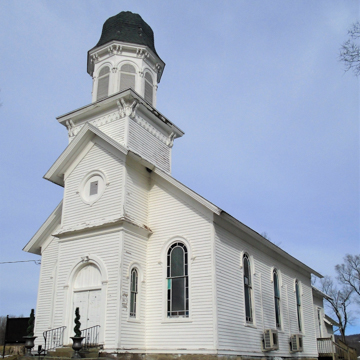You are here
Bethel Congregational Tabernacle (Welsh Hill Church)
The former Welsh Hill Church is a notable expression of ethnic identity and earnest but unsophisticated taste. Welsh began arriving in the area in 1833 and a year later their numbers were sufficient to organize a Welsh congregation. They built a small meetinghouse on rural Cambria Hill in 1839 and when they outgrew that, they built a plain clapboarded frame meetinghouse on an adjoining lot. Beginning in 1887 the meetinghouse was transformed by a remodeling in an Italianate style that was then well out of fashion in urban centers. A bell tower projects from the front, which rises to a hexagonal belfry and its bellshaped roof. A few details—drip molds on the round-arched windows, a rose window (now filled with a louver), and belfry brackets—completed the transformation. The church's interior with its nave plan and pews remains quite plain, except for the decorative panels flanking the recessed alcove behind the raised platform. The congregation continued to worship in the Welsh language until 1893.
Writing Credits
If SAH Archipedia has been useful to you, please consider supporting it.
SAH Archipedia tells the story of the United States through its buildings, landscapes, and cities. This freely available resource empowers the public with authoritative knowledge that deepens their understanding and appreciation of the built environment. But the Society of Architectural Historians, which created SAH Archipedia with University of Virginia Press, needs your support to maintain the high-caliber research, writing, photography, cartography, editing, design, and programming that make SAH Archipedia a trusted online resource available to all who value the history of place, heritage tourism, and learning.


